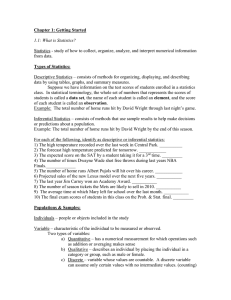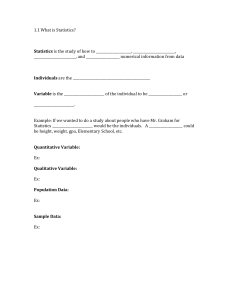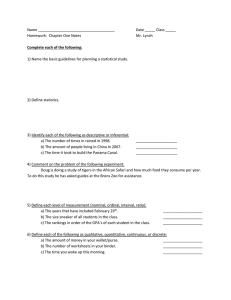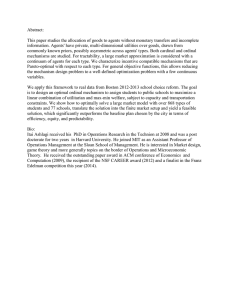Chapter 1: Getting Started information.
advertisement
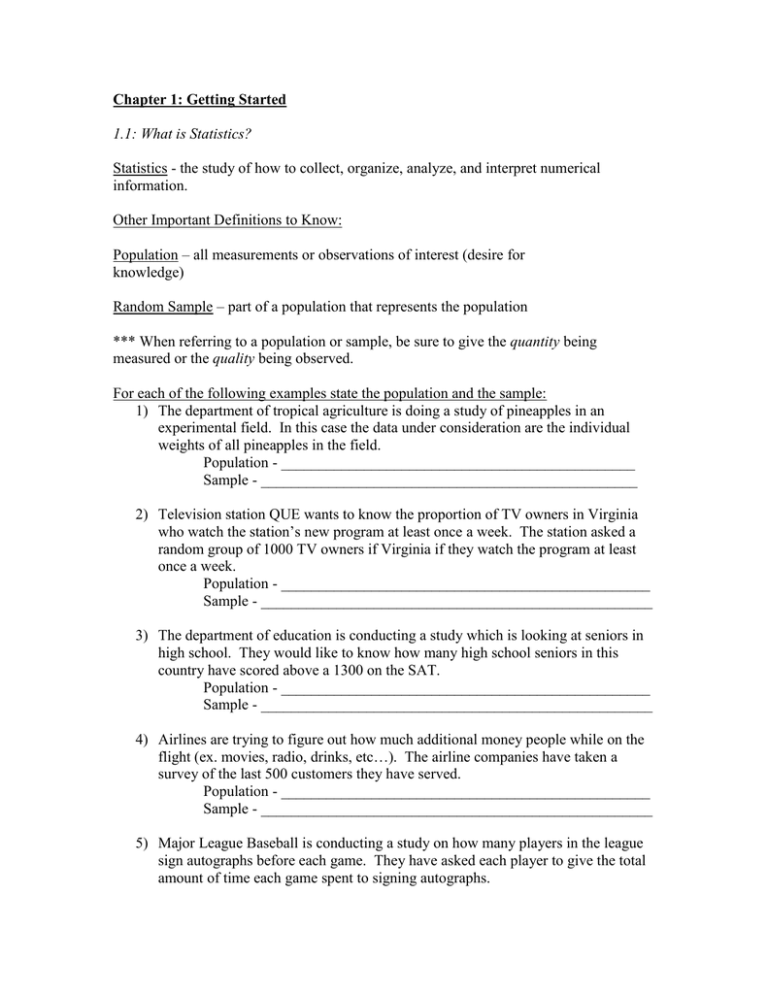
Chapter 1: Getting Started 1.1: What is Statistics? Statistics - the study of how to collect, organize, analyze, and interpret numerical information. Other Important Definitions to Know: Population – all measurements or observations of interest (desire for knowledge) Random Sample – part of a population that represents the population *** When referring to a population or sample, be sure to give the quantity being measured or the quality being observed. For each of the following examples state the population and the sample: 1) The department of tropical agriculture is doing a study of pineapples in an experimental field. In this case the data under consideration are the individual weights of all pineapples in the field. Population - _______________________________________________ Sample - __________________________________________________ 2) Television station QUE wants to know the proportion of TV owners in Virginia who watch the station’s new program at least once a week. The station asked a random group of 1000 TV owners if Virginia if they watch the program at least once a week. Population - _________________________________________________ Sample - ____________________________________________________ 3) The department of education is conducting a study which is looking at seniors in high school. They would like to know how many high school seniors in this country have scored above a 1300 on the SAT. Population - _________________________________________________ Sample - ____________________________________________________ 4) Airlines are trying to figure out how much additional money people while on the flight (ex. movies, radio, drinks, etc…). The airline companies have taken a survey of the last 500 customers they have served. Population - _________________________________________________ Sample - ____________________________________________________ 5) Major League Baseball is conducting a study on how many players in the league sign autographs before each game. They have asked each player to give the total amount of time each game spent to signing autographs. Population - _________________________________________________ Sample - ____________________________________________________ Producing Data: Sample – gaining an accurate picture of the population without disturbing it or disturbing it as little as possible. Experiments – imposing some treatment on units or subjects in order to observe a given response. Simulation – numerical facsimile of real-world phenomena. - “dry lab” (studying real world problems but not going forth with it) Census – measurements from the entire population are used. Which techniques (sampling, experiment, simulation, or census) for gathering data do you think might be the most appropriate for the following studies? 1) Study the effect of stopping the cooling process of a nuclear reactor. ___________ 2) Study the amount of time college students taking a full course load spend watching television. _______________ 3) Study on the effects of a new drug on children with ADHD. ________________ 4) Study on the effects of freezing temperatures on human beings. ______________ 5) Study on the amount of money spent by American on home improvements. ______________ 6) Study the effects of a calcium supplement given to young girls. ______________ 7) Study of the credit hours of each student enrolled at the University of North Carolina at the end of the semester. ______________ 8) Study on the heights of skyscrapers in New York City. _________________ 9) Study which explains the effects of dehydration on athletes. _________________ 10) Study on students at St. Francis who drive cars. _________________ Surveys – asking questions – used after you have decided on sampling or experimentation – often lead to hidden bias or the generalization of results Look at these examples and make comments about the usefulness of the data collected: 1) A uniformed law officer interviews a group of 20 college freshmen. She asks each one his or her name and then if he or she has used an illegal drug in the last month. ____________________________________________________________ ____________________________________________________________ 2) Jessica saw some data that show that cities with more low-income housing have more homeless people. Does building low-income housing cause homelessness? ________________________________________________________________ ________________________________________________________________ 3) A survey about food in the student cafeteria was conducted by having forms available for customers to pick up at the cash register. A drop out box for completed forms was available outside the cafeteria. ________________________________________________________________ ________________________________________________________________ 4) Extensive studies on coronary problems were conducted using men over age 50 as the subjects. ______________________________________________________________ ______________________________________________________________ 5) A survey is conducted in which Americans are asked how much money they put into automobiles each year. This survey was completed by 100 New Yorkers. ______________________________________________________________ ______________________________________________________________ 6) Fast-Food companies were compared with Health-Food companies to look at the overall nutritional value of the food. To conduct this study the researchers compared McDonald’s with Cherry Valley. ______________________________________________________________ ______________________________________________________________ 7) As technology is advancing, so are education techniques. Students with autism can benefit from a curriculum which includes technology. To study this, researchers incorporated technology into a classroom at PS 145. ______________________________________________________________ ______________________________________________________________ *** Good statistics and expertise in a given field must work together to give reliable results. Levels of Measurement: 1) Nominal – lowest level, “in name only” - consist of names only or qualities with no implied criteria by which the data can be identified as greater than or less than other data items. Example: Mets, Yankees, and Jets are the names of three professional teams from the population of all professional teams in New York. 2) Ordinal – data may be arranged in some order, but actual differences between data values either cannot be determined or are meaningless. Example: In CHSAA Football, St. Francis Prep ranks 1st, St. Anthony’s 2nd, Mount St. Michael 3rd, and Holy Cross 99th. 3) Interval – has same qualities as ordinal level, but it has the additional property that meaningful differences between data values can be computed. Example: Body temperature (in degrees Celsius) of trout swimming in the Yellowstone River. 4) Ratio – highest level, similar to the interval level, but includes an inherent zero as a starting point for all measurements. Example: Length of trout swimming in the Yellowstone River. Level of Measurement: Nominal Ordinal Interval Ratio Suitable Calculation: We can put the data into categories. We can order the data from smallest to largest or “worst to “best.” Each data value can be compared with another data value. We can order the data and also take the differences between data values. At this level, it makes sense to compare the differences between data values. For instance, we can say that one data value is 5 more than another or 12 more than another data value. We can order the data, take differences, and also find the ratio between data values. For instance, it makes sense to say that one data value is twice as large as another. For each of the following examples, indicate the corresponding level of measurement: 1) Length of time it takes to run a mile. _________________ 2) The name of your older sibling. ______________ 3) Age of people in this class. _____________ 4) The years that the Tarheels have won the national championship. __________ 5) The food in the cafeteria can be rated: poor, acceptable, good. ____________ 6) Hyundai produces the Sonata, Elantra, and Azera. ___________ 7) In a high school graduating class, Joe ranks 45th and Jen ranks 12th. ________ 8) Amount of times that Democrats have won the presidential election. _______ 9) Length of trout swimming in the Yellowstone River. _____________ 10) Music, Math, and Science are three subjects that Sean goes to summer school for. _____________ Descriptive Statistics – the organization of data. Example: The total number of home runs hit by David Wright through last night’s game. Inferential Statistics – methods of using a sample to obtain information about a population. Example: The total number of home runs hit by David Wright by the end of this season. For each of the following, identify as descriptive or inferential statistics: 1) The high temperature recorded over the last week in Central Park. __________ 2) The forecast high temperature predicted for tomorrow. ____________ 3) The expected score on the SAT by a student taking it for a 3rd time. _________ 4) The number of times Dwayne Wade shot free throws during last years NBA Finals._____________ 5) The number of home runs Albert Pujols will hit over his career. ____________ 6) Projected sales of the new Lexus model over the next five years. ___________ 7) The last year Jim Carrey won an Academy Award. ___________ 8) The number of season tickets the Mets are likely to sell in 2010. ___________ 9) The average time at which Mary left for school over the last month. ___________ 10) The final exam scores of students in this class on the Prob. & Stat. final. _________ 1.2: Calculators & Computers in Statistics *** If you are unsure of something basic in the calculator, take a look at the manual you were given when you purchased it. 1.3: Where Will I Use Statistics “In almost any field that you may find you are required to present data in a meaningful way.”
